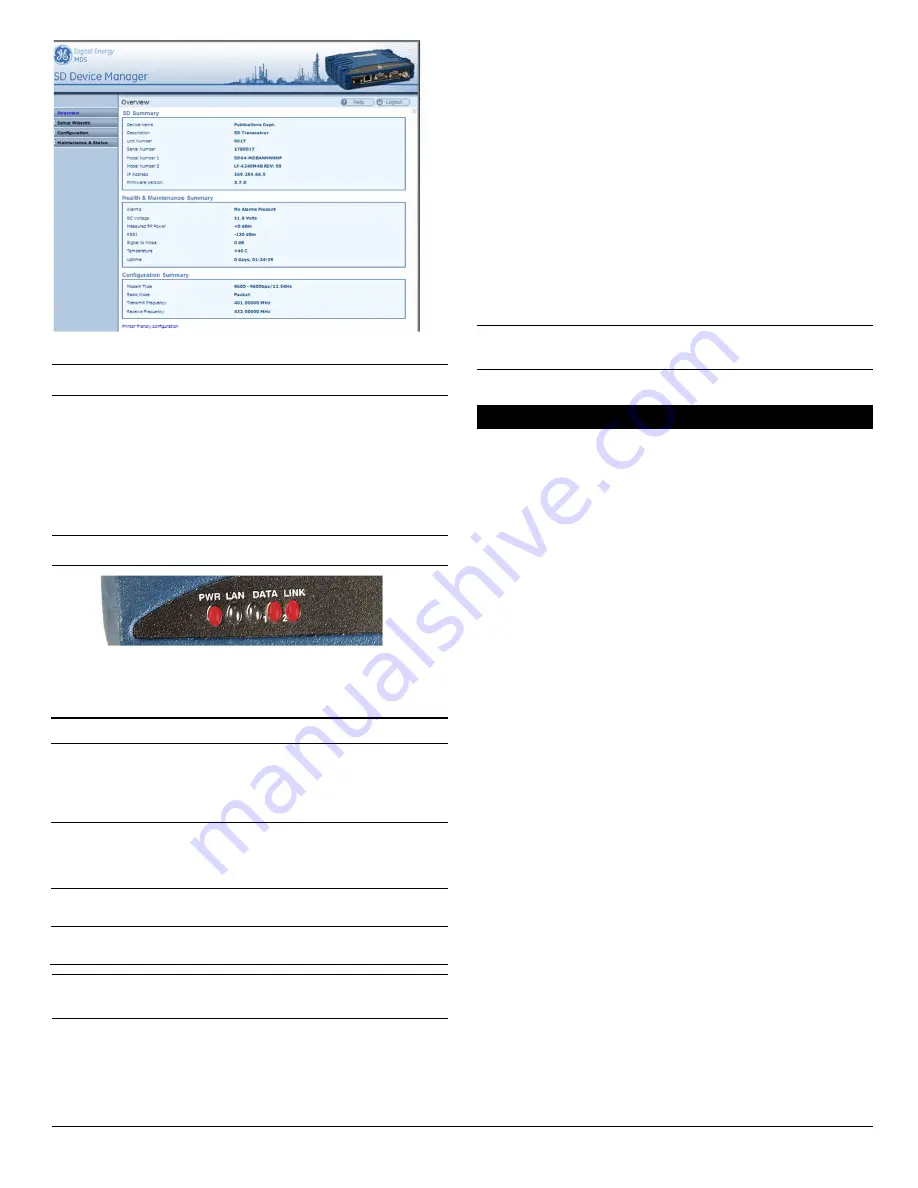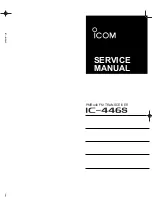
05-4847A01-GB, Rev. B
MDS SD Series Setup Guide
3
Figure 8. Overview Summary Screen
NOTE
: The radio may also be programmed using serial or Telnet
management methods. Refer to the
Technical Manual
for details.
2.2 Initial Checkout
In-service operation of the transceiver is completely automatic.
The only operator actions required are to apply DC power and
observe the LEDS for proper indications.
Table 1
summarizes the
radio’s LED functions.
2.2.1 LED Functions
NOTE
: LED labeling may vary on early units. LED position and
functionality remains as described below.
Figure 9. LED Status Indicators
Table 1: Description of LED Status Indicators
LED Name
Description
PWR
POWER:
• Continuous—Power applied, no problems
detected.
• Rapid flash (5 times-per-second)—Alarm
indication.
LAN
ETHERNET:
• Flashing—Ethernet data activity is detected.
• Off—Ethernet signals not detected, or excessive
traffic is present.
DATA 1/2
DATA1 / DATA2: The DATA LEDs show data
activity on the DB-9 serial payload port(s).
LINK
LINK: When lit, indicates that a communication link
exists with the another station.
NOTE
: In addition to the LEDs above, the Ethernet connector
also has two embedded LEDs. A flashing green indicates Ether-
net data activity. A yellow indicates 100 Mbps operation.
2.2.2 Antenna SWR Check
The antenna system’s standing wave ratio (SWR) should be
checked on new installations using a wattmeter suited to the fre-
quency of operation. High SWR (above 2:1) may indicate an an-
tenna or feedline problem.
2.2.3 RSSI Check (for Remotes)
Using the Maintenance & Status>>Performance screen, check
the received signal strength indication (RSSI). The radio must be
receiving a signal from the associated Master Station (LINK LED
on or blinking). In general, signal levels stronger than –80 dBm
will provide reliable communication and allow for a degree of
“fade margin.”
Optimize the RSSI at Remotes by slowly adjusting the direction
of the station antenna. Watch the RSSI indication for several sec-
onds after making each adjustment, so that the RSSI accurately
reflects the new heading. With RSSI readings, the less negative
the number, the stronger the incoming signal.
NOTE
: The radio’s RSSI facility limits the maximum displayed
signal strength to -60 dBm. A receive signal attenuator is availa-
ble in the
Configuration>>Radio>>Advanced Settings
screen.
3 Troubleshooting
All radios in the network must meet the basic requirements listed
below for proper operation. Check these items first when trouble-
shooting a system problem:
Adequate and stable primary power
Secure connections (RF, data and power)
A clear transmission path between Master and each Remote
An efficient and properly aligned antenna system providing ad-
equate received signal strength.
Proper programming of radio settings
The correct interface between the transceiver and the con-
nected data equipment (correct cable wiring, proper data for-
mat, timing, etc.)
3.1 LEDs
The radio’s LED indicator panel provides useful information when
troubleshooting a system problem. Refer to
Table 1
for LED indi-
cations.
3.2 Event Codes
When an alarm condition exists, the transceiver creates a mes-
sage readable on the
Maintenance & Status
Screen. From this
screen, select
Event Log
to view the current alarm(s). Consult
the
Technical Manual
for details.
3.2.1 Types of Alarms
Minor Alarms—
These alarms report conditions that, under most
circumstances will not prevent transceiver operation. This in-
cludes out-of-tolerance conditions, baud rate mismatches, etc.
The cause should be investigated and corrected to prevent sys-
tem failure.
Major Alarms
—These alarms report serious conditions that gen-
erally indicate a hardware failure, or other abnormal condition
that will prevent (or seriously hamper) further operation of the
transceiver. Major alarms may require factory repair. Contact
your factory representative for assistance.
3.3 Built-In Spectrum Analyzer/Graph
A Spectrum Analyzer/Graph is available to display other radio
signals near the SD radio’s operating frequencies. This can be a
helpful tool in cases of interference. The graph may be accessed
from the
Maintenance & Status>>Radio Test
screen.























